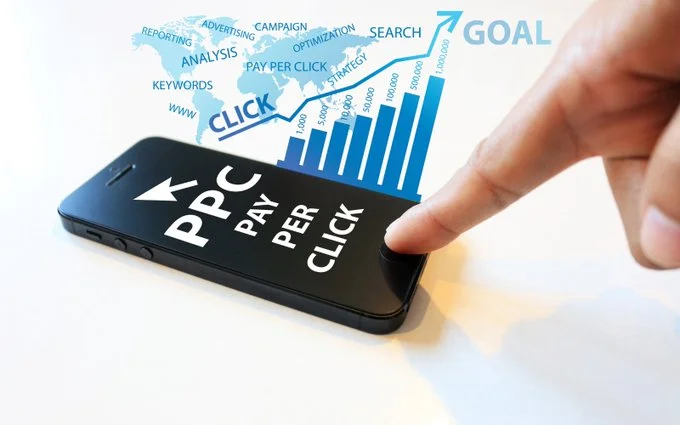Paid search, also known as Pay-Per-Click (PPC) advertising, is a digital marketing strategy that allows businesses to display targeted advertisements on search engine results pages (SERPs) and other online platforms. Here’s a breakdown of the key aspects:
- Targeted Ads: You create ads based on specific keywords relevant to your product or service.
- Search Engine Results Pages (SERPs): When users enter a search query related to your keywords, your ads might appear at the top or bottom of the search results page, clearly marked as “Ad.” Some platforms also allow displaying ads on partner websites and apps.
- Pay-Per-Click (PPC): You only pay when someone clicks on your ad. This makes paid search a cost-effective way to reach potential customers who are actively searching for what you offer.
1. Define Your Goals and Objectives For Paid Search
Before diving into campaign creation, it’s crucial to establish clear goals and objectives. What do you hope to achieve with your paid search efforts? Here are some common goals:
- Increase brand awareness: Raise visibility for your brand and reach a wider audience.
- Generate leads: Capture user information for further marketing efforts.
- Drive website traffic: Increase the number of visitors to your website.
- Boost online sales: Convert website visitors into paying customers.
- Promote app downloads: Encourage users to download your mobile app.
Once you define your goals, translate them into specific, measurable objectives. This could involve setting targets for website traffic, conversion rates, or cost-per-acquisition (CPA). By setting clear objectives, you can track your progress, measure campaign success, and make adjustments as needed.
2. Know Your Target Audience
Understanding your ideal customer is fundamental to an effective PPC campaign. Consider factors like demographics, interests, online behavior, and pain points. Conduct market research, analyze competitor strategies, and leverage customer data to build detailed buyer personas. Targeting the right audience ensures your ads reach individuals most likely to convert.
3.Keyword Research and Selection
Keywords are the foundation of any successful paid search campaign. They are the terms users enter into search engines to find information or products. Thorough keyword research allows you to identify relevant keywords with high search volume and low competition. Tools like Google Keyword Planner, SEMrush, and Ahrefs can be valuable resources for keyword research.
While focusing on high-volume keywords is tempting, don’t neglect long-tail keywords. These are more specific keyword phrases with lower search volume but potentially higher conversion rates because they target users further along the buying journey.
Pro Tip:
Organize your keywords into tightly-themed ad groups to ensure your ads are highly relevant to the user’s search query. This improves ad relevance scores and potentially lowers your cost-per-click (CPC).
4. Craft Compelling Ad Copy

Your ad copy is the first impression potential customers have of your brand. Make it count! Write clear, concise, and compelling ad copy that:
- Highlights your unique selling proposition (USP): What sets you apart from the competition?
- Targets user pain points: Address the challenges your ideal customer faces.
- Includes a strong call to action (CTA): Tell users what you want them to do (e.g., visit your website, download a white paper).
- Emphasizes benefits: Focus on how your product or service improves user lives.
- A/B test different ad variations: Test different headlines, descriptions, and CTAs to see what resonates best with your audience.
5.Optimize Your Landing Pages
Your landing page is the destination where users arrive after clicking your ad. It’s crucial to optimize your landing pages for conversions. Here are some key elements:
- Match landing page content to your ad copy: Create a seamless user experience by ensuring the landing page addresses what the ad promised.
- Clear value proposition: Clearly communicate the benefits users will receive by taking action.
- Strong CTA: Make it easy for users to convert with a prominent and clear call to action.
- Mobile-friendliness: Ensure your landing page is optimized for mobile devices, as a significant portion of searches occur on smartphones.
- Fast loading speed: A slow loading time can lead to frustrated users and missed conversions. Optimize your landing page for speed to improve user experience.
6.Leverage Management Strategies
Bidding strategies determine how much you’re willing to pay for each ad click. There are various bidding options available on PPC platforms like Google Ads and Microsoft Ads. Here’s an overview of some common strategies:
- Manual Bidding: You manually set the maximum cost-per-click (CPC) you’re willing to pay for each keyword.
- Enhanced CPC (ECPC): Google Ads automates bids while allowing you to set a maximum bid.
- Target CPA: Set a target cost per acquisition, and the platform automatically adjusts bids to optimize for reaching your CPA goal.
- Maximize Clicks: Focus on maximizing the number of clicks within your daily budget.
Choosing the right bidding strategy depends on your campaign goals. Experiment with different strategies to see what works best for your specific needs.
7.Utilize Ad Extensions
Ad extensions enhance your ads and provide users with additional information, increasing ad visibility and potentially improving click-through rates (CTR). Here are some popular ad extensions:
- Sitelink Extensions: Add links to specific pages on your website.
- Call Extensions: Allow users to call your business directly from the ad.
- Location Extensions: Showcase your business address and location on a map.
- Callout Extensions: Highlight key features or benefits of your product or service.
- Structured Snippets: Provide specific details about your offerings, like product prices or promotions.
Utilizing relevant ad extensions can significantly improve the performance of your paid search campaigns.
8.Tracking and Analytics
Effectively measuring your results is essential for optimizing your PPC campaigns. Set up conversion tracking to monitor user actions on your website, such as purchases, form submissions, or phone calls. Analyze key metrics like impressions, clicks, conversions, cost-per-click (CPC), and conversion rate.
Platforms like Google Ads and analytics tools like Google Analytics provide valuable insights into your campaign performance. Use this data to identify areas for improvement, refine your targeting, and optimize bids.
Pro Tip:
Track conversions beyond the initial click. Attribution modeling allows you to understand the role different touchpoints (e.g., display ads, organic search) play in influencing conversions.
9.Embrace Negative Keywords
Negative keywords help you prevent your ads from showing for irrelevant search queries. This saves you money and ensures your ads reach users genuinely interested in your products or services.
For example, if you sell high-end running shoes, you might add negative keywords like “cheap running shoes” or “used running shoes” to avoid irrelevant clicks. Regularly review your search terms report and add negative keywords to refine your targeting further.
10.Continuous Monitoring and Optimization
Paid search is an ongoing process. It’s crucial to continuously monitor your campaign performance and make adjustments as needed. Analyze your data, identify areas for improvement, and test different strategies to optimize your campaigns for maximum ROI.
Here are some ongoing optimization tactics:
- A/B test different ad variations: Test different headlines, descriptions, and CTAs to see what resonates best with your audience.
- Refine your keyword targeting: Add new relevant keywords, remove underperforming ones, and adjust your match types for optimal targeting.
- Optimize your landing pages: Continuously test and improve your landing pages to increase conversions.
- Monitor competitor strategies: Stay informed about industry trends and competitor strategies to maintain a competitive edge.
By following these best practices and remaining data-driven in your approach, you can maximize your ROI and achieve success with your paid search campaigns.
Please share your thoughts in the comments. At theproductrecap.com, we are open to friendly suggestions and helpful inputs to keep awareness at peak.




